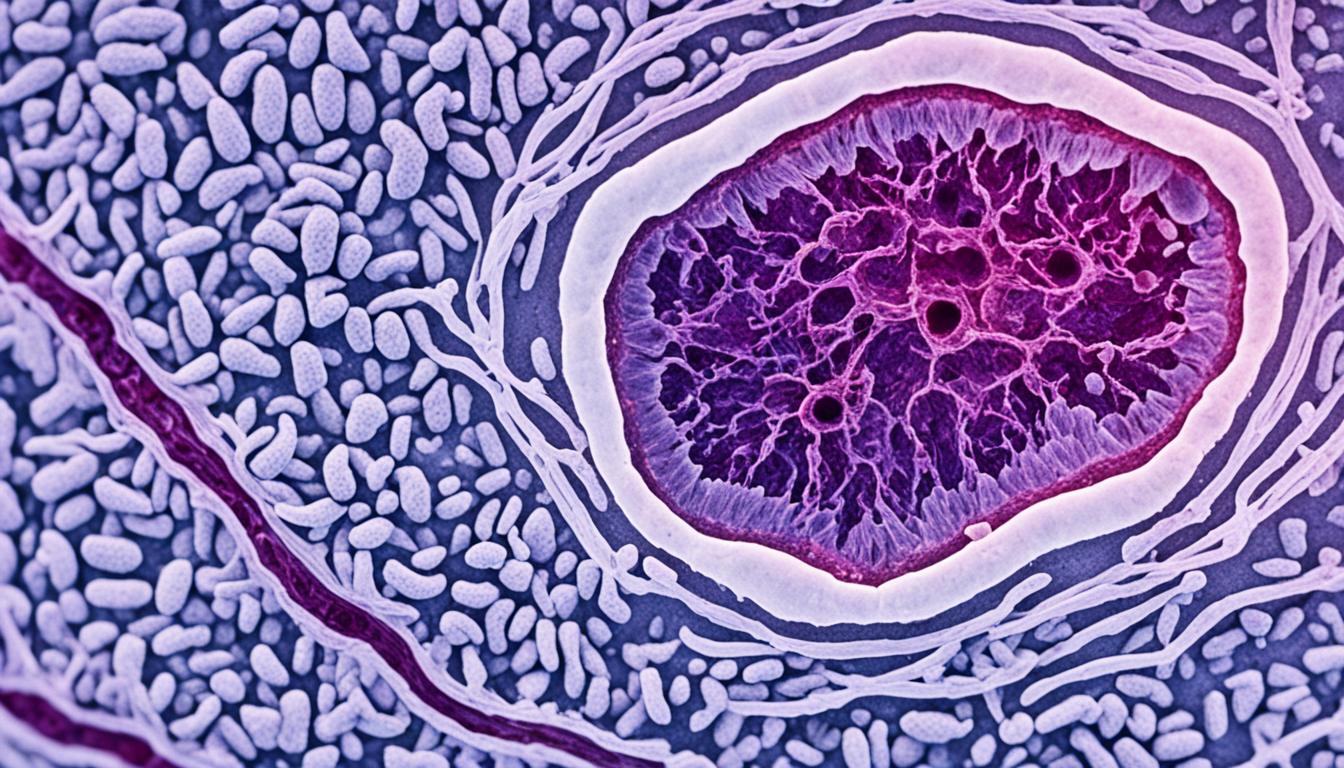Ampullary cancer grows in the ampulla of Vater where two ducts join. It is a rare type of cancer, making up only 0.2% of GI cancers. It mostly affects people in their 70s. This cancer can greatly change a person’s life and impact their family.
Most cases of ampullary cancer happen without a known cause. But, there are some conditions that can make a person more likely to get it. For example, hereditary polyposis syndromes and hereditary nonpolyposis colorectal cancer can raise the risk.
Beyond usual methods, new ways to treat cancer are being looked into. Stem cell therapy is one of these new approaches. It uses special cells that can help fix damaged tissues. Although this method shows promise, more study is needed to know for sure if it’s safe and effective.
Key Takeaways:
- Ampullary cancer is a rare form of gastrointestinal cancer that affects the ampulla of Vater.
- Hereditary polyposis syndromes and hereditary nonpolyposis colorectal cancer are associated with an increased risk of developing ampullary cancer.
- Stem cell therapy is an emerging potential treatment option for ampullary cancer.
- Further research is necessary to fully assess the efficacy and safety of stem cell therapy in ampullary cancer.
- Early detection and proper medical management are crucial in improving outcomes for individuals with ampullary cancer.
Ampullary Cancer: Presentation and Symptoms
Ampullary cancer is a rare GI cancer that affects the ampulla of Vater. Knowing the symptoms is key for spotting it early.
Common Symptoms:
- Jaundice is the top symptom. It makes your skin and eyes yellow because bile can’t flow properly.
- Unplanned weight loss is a big hint of this cancer. Losing weight without trying is a sign to watch for.
- Abdominal pain varies in severity. It can be mild or intense, but it’s often felt by many.
- Dark urine, pale stools, and itching signal biliary obstruction. These occur when the cancer blocks the bile duct.
- Some might see blood in their stool or vomit if they have ampullary cancer. This means there could be internal bleeding.
Symptoms can change based on the cancer’s stage and where it’s located. They are similar to other gut problems, so getting the right diagnosis is crucial.
| Symptom | Frequency | Severity |
|---|---|---|
| Jaundice | Frequent | Moderate to severe |
| Weight loss | Common | Mild to moderate |
| Abdominal pain | Common | Mild to severe |
| Biliary obstruction | Frequent | Mild to severe |
| Gastrointestinal bleeding | Occasional | Mild to moderate |
Ampullary Cancer: Diagnosis and Staging
Doctors use imaging and biopsies to diagnose ampullary cancer. CT scans show detailed images around the ampulla of Vater. They help spot any issues or tumors. These scans are critical for finding ampullary cancer early.
Biopsies confirm if someone has ampullary cancer. A doctor takes a tiny tissue sample from the tumor. Looking at this under a microscope shows if it’s cancer. This step is key for starting the right treatment.
After diagnosis, doctors categorize the cancer’s stage. They use the TNM system. This system looks at the tumor’s size, if it’s in lymph nodes, and if it has spread elsewhere. Staging shows how aggressive the cancer is and informs treatment choices.
Staging the cancer helps doctors pick the best treatment. Early cancers limited to the ampulla of Vater might just need surgery. But more advanced cancers might need surgery, chemo, or radiation. This combination can help target cancer cells everywhere they might be.
Diagnosis and staging are crucial for managing ampullary cancer. They give essential details about the cancer’s reach. This information directs how doctors can best treat their patients.
TNM Staging System for Ampullary Cancer
| Stage | Tumor | Lymph Nodes | Metastasis |
|---|---|---|---|
| Stage 0 | Tis | N0 | M0 |
| Stage I | T1 | N0 | M0 |
| Stage II | T2 | N0 | M0 |
| Stage III | T3 | N0 | M0 |
| Stage IVa | T1-T3 | N1 | M0 |
| Stage IVb | T4 | Any N | M0 |
| Stage IVc | Any T | Any N | M1 |
Ampullary Cancer Treatment Options
Ampullary cancer treatment options differ based on the cancer stage. Main treatments include surgery, chemotherapy, and radiation therapy.
Surgery
For early-stage cases, surgery is common. The Whipple procedure takes out parts such as the ampulla of Vater, pancreas, and duodenum. This surgery aims to remove the tumor and related lymph nodes.
Chemotherapy
Chemotherapy is vital for ampullary cancer care. Before surgery, it can reduce the tumor’s size. After the operation, it helps kill any left cancer cells. Gemcitabine is often used for this cancer.
Radiation Therapy
Radiation may also be needed, often with chemotherapy. Beams of high energy are directed at the cancer to kill it. This treatment can help manage cancer and reduce symptoms like bile duct blockages.
Choosing the right treatment considers cancer stage and the person’s health and wishes. A team of experts, including oncologists and surgeons, helps tailor the plan.
| Treatment Option | Indications | Advantages | Disadvantages |
|---|---|---|---|
| Surgery | Early-stage ampullary cancer | Complete removal of the tumor | Potential surgical complications |
| Chemotherapy | Neoadjuvant and adjuvant therapy | Targets cancer cells throughout the body | Possible side effects |
| Radiation Therapy | Locally advanced or unresectable tumors | Can control local tumor growth | Potential damage to surrounding tissues |
Ampullary Cancer: Recurrence and Prognosis
After beating ampullary cancer, recurrence is a worry. It often comes back in the liver. How well a person fights it depends a lot on when the cancer was found. The earlier, the better.
When ampullary cancer is found early, the chances of living 5 more years are good, at 70-80%. But if it spreads, the chance drops to 20-50%. Early finding and treatment make a big difference.
Visiting the doctor regularly after treatment is crucial. They will check for any sign of cancer coming back. This may include CT scans and other tests.
Remember, everyone’s case is different. Your general health and how well you respond to treatment matter a lot. Always follow up with your doctor for tailored advice and help.

Ampullary Cancer: Support and Resources
Living with ampullary cancer is tough. A strong support system is key to mental health and getting through the hard times. There are many resources out there. These include cancer support groups and chances to join clinical trials.
Joining Cancer Support Groups
Connecting with those facing similar challenges helps a lot. It can give you comfort and valuable insights. Support groups create a community. Here, people can swap stories, advice, and find empathy.
Some cancer support groups that may help are:
- The Cancer Survivors Network
- Let’s Win! Pancreatic Cancer Support Group
In these safe spaces, you can share worries, ask questions, and learn from others. Joining such groups can make you and your loved ones feel supported on your path.
Exploring Clinical Trials
Clinical trials look for new ways to fight cancer, including ampullary cancer. Taking part in a trial can offer access to leading treatments not yet widely available.
Talking to your doctor about clinical trials is important. They can help you see if you’re eligible and understand the risks and rewards. Trials also give you a chance to help push cancer research forward.
Turning to support groups and clinical trials can be beneficial for those with ampullary cancer. They offer emotional support, community, and access to new treatments. Always remember, there are resources and people ready to lend a hand in your journey.
Ampullary Cancer: Ribbon Color and Awareness
Ampullary cancer doesn’t have its own ribbon color. Yet, wearing the right colored ribbons can still help raise awareness and show support. This is for everyone fighting ampullary cancer and their families.
Purple: Pancreatic cancer uses the purple ribbon for awareness. Ampullary and pancreatic cancers are similar in where they are and how they’re treated. That’s why the purple ribbon works well for both.
Blue: The blue ribbon stands for colon cancer. Both ampullary and colon cancer affect the gut. Knowing about colon cancer can help understand ampullary cancer better.
Kelly Green: Kelly green is for gallbladder and bile duct cancer. These also concern the gut. Pointing out their link to ampullary cancer can raise more awareness.
Light purple or lavender ribbons are for all cancer types. They show support for those with ampullary cancer and other cancers too.
Let’s come together to spread the word about ampullary cancer. By wearing these colored ribbons, we make a community. We support and help everyone fighting this rare cancer.
Ampullary Cancer: Research and Genetic Landscape
Ampullary cancer is an area of ongoing research. Scientists aim to grasp its genetic makeup and the paths by which it grows. They have found that several signaling routes are key players in the cancer’s journey, such as:
1. EGFR (Epidermal Growth Factor Receptor)
EGFR is a crucial cell surface receptor. It controls how cells grow and divide. When EGFR signaling goes wrong, it can fuel ampullary cancer’s growth and spread.
2. WNT (Wingless/Integrated)
The WNT pathway normally helps organs grow correctly and stay healthy. But in ampullary cancer, this pathway goes haywire. It leads to more cell growth and larger tumors.
3. TGF-β (Transforming Growth Factor-β)
TGF-β is a major player in many cell activities. When its role is disturbed, it can help ampullary cancer form and progress. This disruption changes how cells grow, specialize, and die.
4. PI3K/AKT/mTOR (Phosphatidylinositol 3-Kinase/AKT/mammalian Target of Rapamycin)
The PI3K/AKT/mTOR pathway is big in controlling cell processes. In ampullary cancer, changes in this pathway boost cell growth. This makes the cancer spread more rapidly.
5. MET (Mesenchymal-Epithelial Transition Factor)
MET is essential for cell survival, growth, and movement. When MET signaling is off in ampullary cancer, it aids in forming the disease. Plus, it helps it spread to other parts of the body.
6. SWI/SNF Chromatin-Remodeling Complexes
SWI/SNF groups reshape how genes work by adjusting chromatin. In ampullary cancer, these complexes sometimes show mutations or changes. This can cause irregular gene behavior and tumor growth.
7. MicroRNAs
MicroRNAs are tiny RNAs that fine-tune gene activities. In ampullary cancer, they are not working as they should. This impacts many cell activities connected to cancer development.
Researching ampullary cancer’s genetic and molecular aspects is key. It could unlock new treatments and better ways to treat this less common type of stomach cancer.
Conclusion
Ampullary cancer is a rare type of cancer in the digestive system. It mainly affects the ampulla of Vater. Patients with this cancer may show signs like yellow skin, losing weight, and pain in the stomach. Doctors use tests like images and biopsies to find out how advanced the cancer is.
The treatment for ampullary cancer changes with the cancer’s stage. If the cancer hasn’t spread, surgery like the Whipple procedure is common. After surgery, chemotherapy helps to kill any remaining cancer cells. Patients can also find help in support groups and through joining clinical trials.
There’s no single ribbon color for ampullary cancer, but wearing a purple ribbon for pancreatic cancer or a blue one for colon cancer can still help show support. The outlook for this cancer depends on its stage. If caught early, the chances of getting better are higher than in later stages.

